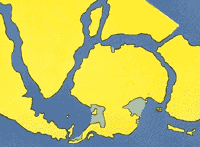|


|

|
|
|
©
NSF
|
|
|
Gondwanaland,
around 150 million years ago, before the land mass that
is now Antarctica separated from the land mass that is
now South America.
|
|
|
|
Mutating
Genes and Shifting Continents
Notothenioids did not attain their regal status in the Antarctic
marine ecosystem by chomping other species to oblivion. Rather,
scientists believe that the dominance of the Notothenioids
is a product of genetic and geological history.
Up
until about 30 million years ago, researchers say, the waters
around Antarctica were warmer than they are today. That’s
because South America was connected to Antarctica (
see
map at right
), allowing warm air from the north to flow
into Antarctic waters.
Fossil
evidence indicates that the warmer waters permitted a greater
diversity of marine fish species than there is today; many
different groups of fish species thrived. The 90 or so Notothenioid
species that inhabit Antarctica today did not exist—only
a single ancestral Notothenioid species.
But
sometime between 5 and 14 million years ago, the confluence
of two changes—one genetic and one geological—radically
changed this species distribution.
The
genetic event was a tiny change, or mutation, in the DNA of
an ancestral Notothenioid. The mutation created a DNA segment
in the fish that coded for an antifreeze protein.
But
the ocean was warmer at the time, so the Notothenioids didn’t
need the protein. As a result, the mutation neither helped
nor hurt survival chances—and had no significant impact
on the population of antifreeze-protein carriers.
Around
the same time, a shift in the earth’s continental plates
changed the shape of the Earth's land masses, ripping off
the tail end of South America from what is today Antarctica.
The resulting unbroken band of seas around Antarctica created
a powerful water current encircling the continent, preventing
Antarctic waters from mixing with warmer seas. Over time,
the Antarctic seas grew much colder.

The
current patterns around Antarctica today.
|
